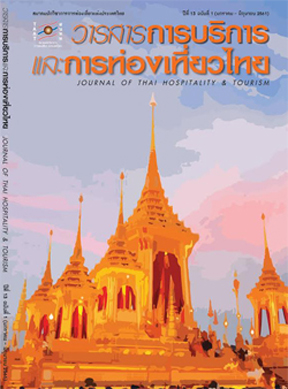การสำรวจมาตรฐานคุณภาพแหล่งท่องเที่ยวเชิงนิเวศในเขตอุทยานแห่งชาติปางสีดา จังหวัดสระแก้ว
Main Article Content
บทคัดย่อ
การวิจัยนี้เป็นการสำรวจมาตรฐานคุณภาพแหล่งท่องเที่ยวเชิงนิเวศในเขตอุทยานแห่งชาติปางสีดาจังหวัดสระแก้ว มีวัตถุประสงค์ เพื่อประเมินมาตรฐานคุณภาพแหล่งท่องเที่ยวเชิงนิเวศในเขตอุทยานแห่งชาติปางสีดา และเพื่อศึกษาศักยภาพองค์ประกอบสี่ด้านของแหล่งท่องเที่ยวเชิงนิเวศ คือ ศักยภาพในการเป็นแหล่งท่องเที่ยวเชิงนิเวศ การจัดการด้านการใช้ประโยชน์ของพื้นที่ การให้ความรู้และการสร้างจิตสำนึกแก่นักท่องเที่ยว และการมีส่วนร่วมของชุมชน กลุ่มตัวอย่างที่ใช้ในการวิจัยมาจากบุคคลหลายอาชีพ จำนวน 5 กลุ่ม กลุ่มละ 30 คน เครื่องมือที่ใช้ในการเก็บข้อมูลเป็นแบบประเมินมาตรฐานคุณภาพแหล่งท่องเที่ยวเชิงนิเวศ จากกรมการท่องเที่ยว สถิติที่ใช้ในการวิเคราะห์ข้อมูลได้แก่ ค่าเฉลี่ยและค่าร้อยละ ผลจากการวิจัยพบว่ามาตรฐานคุณภาพแหล่งท่องเที่ยวเชิงนิเวศในเขตอุทยานแห่งชาติปางสีดาอยู่ในระดับดี ศักยภาพองค์ประกอบของแหล่งท่องเที่ยวแต่ละด้านอยู่ในระดับดี ผลจากการวิจัยมีข้อเสนอแนะดังนี้ 1) การจัดการท่องเที่ยวเชิงนิเวศ ต้องคำนึงถึงมาตรฐานคุณภาพและศักยภาพของแหล่งท่องเที่ยว 2) การจัดกิจกรรมการท่องเที่ยวควรให้ทุกภาคส่วนของสังคมเข้ามามีส่วนร่วม 3) การจัดกิจกรรมการท่องเที่ยวควรคำนึงถึงความยั่งยืนของแหล่งท่องเที่ยว 4) การจัดการท่องเที่ยวเชิงนิเวศในเขตอุทยานแห่งชาติปางสีดาควรคำนึงถึงความเป็นมรดกโลกของอุทยานแห่งชาติปางสีดาด้วย
Article Details

อนุญาตภายใต้เงื่อนไข Creative Commons Attribution-NonCommercial-NoDerivatives 4.0 International License.
เอกสารอ้างอิง
[2] Department of Tourism, Thailand. (2014). Summary of Tourist Statistics who travel to the National Parks in Thailand. Bangkok: Department of Tourism.
[3] Division of Attraction Development, Department of Tourism, Thailand. (2005). Guideline for Quality Standard of Ecotourism Destination Assessment. Bangkok: Division of Attraction Development.
[4] Economist Intelligence Unit. (1991). Bhutan: International Tourism Reports. Madrid: World Tourism Organization.
[5] Emphandh, Dachanee. et al. (2004). Guideline for Ecotourism Region Classification. Bangkok: Kasetsart University.
[6] Fennell, D. A., & Dowling, R. K. (eds.). Ecotourism Policy and Planning. Wallingford, England: CABI Publishing.
[7] Goodfellow, D. (1992). Host versus Guest: The Desires and Concerns of Passengers on Society Expedition’s Ship World Discovery. In B. Weiler. (ed.). Ecotourism: In Cooperating the Global Classroom. International Conference Papers. Canberra: Bureau of Tourism Research.
[8] Gurung, C. P., & De Coursey, M. (1994). The Annapurna Conservation Area Project:A Pioneering Example of Sustainable Tourism. Chichester, England: John Wiley & Sons.
[9] Hall, M. V. (1994). Ecotourism in Australia, New Zealand and the South Pacific: Appropriate Tourism or a New Form of Ecological Imperialism. Chichester, England: John Wiley & Sons.
[10] Hui, J. (1990). Tourism Bank Study. South Australia: Joseph Banks Group.
[11] Lindberg, K. (1991). Policies for Maximizing Nature Tourism’s Ecological and Economic Benefits. Washington D.C.: Word Resources Institute.
[12] Ministry of Tourism and Sports. (2011). National Tourism Development Plan 2012–2016. Bangkok: Ministry of Tourism and Sports.
[13] Office of Natural Resources and Environmental Policy and Planning. (2002). Quebec Declaration on Ecotourism. Public on Ecotourism. Bangkok: Ministry of Natural Resources and Environment.
[14] Office of Sa Kaew Province. (2011). Development Strategy of Sa Kaew Province 2011–2013. Thailand: Sa Kaew Province.
[15] Place, S. (1998). The Impact of Natural Park Development on Tortuguero Costa Rica. Journal of Cultural Geography, 9, 37–52.
[16] Poon, A. (1994). The New Tourism Revolution. Tourism Management, 15, 91–92.
[17] Sa Kaew Province. (2010). Development Plan of the Sa Kaew Province 2010–2013. Thailand: Sa Kaew Province.
[18] Shackly, M. (1994). The Land of Lo, Nepal–Tibet: The First Eight Months of Tourism. Tourism Management: Research, Policies, Practices, 15, 17–26.
[19] Shang, C. T. (2003). The Study on Ecotourism Theory. Doctoral Dissertation. Tianjin, People’s Republic of China: Tianjin University. Retrieved from ProQuest Dissertations Publishing.
[20] Tourism Authority of Thailand (TAT). (2001). Policy on the Promotion of Thailand Ecotourism. Bangkok: Tourism Authority of Thailand.
[21] Tourism Authority of Thailand (TAT). (2004). The New Era of Thailand Ecotourism Industry in the World Stage. Bangkok: Tourism Authority of Thailand.
[22] United Nations Development Programme. (1997). Guideline: Development of National Parks and Protected Areas for Tourism. Paris: United Nations Development Programme.
[23] Wannalert, Sutat. (2004). Guide for Ecotourism Region Classification. Bangkok: Department of Conservation Science, Kasetsart University.
[24] Weaver, D. (1994). Ecotourism in the Caribbean Basin. In E. Carter & G. Lowman. (eds.). Ecotourism. Chichester, England: John Wiley & Sons.
[25] Wells, M. P., & Brandon, K. (1992). People and Parks: Linking Protected Area Management with Local Communities. Washington D.C.: World Bank.


